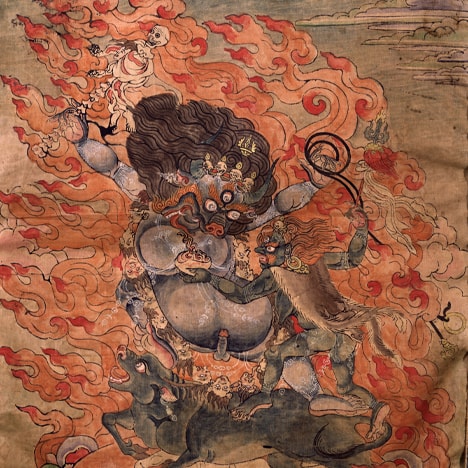
About the Meditation
Meditation session led by Tracy Cochran.
The guided meditation begins at 11:39.
For centuries Himalayan practitioners have used meditation to quiet the mind, open the heart, calm the nervous system, and increase focus. Now Western scientists, business leaders, and the secular world have embraced meditation as a vital tool for brain health.
Whether you’re a beginner, a dabbler, or a skilled meditator seeking the company of others, join expert teachers in a forty-five-minute weekly program designed to fit into your lunch break. Each session will be inspired by a different work of art from the Rubin Museum’s collection and will include an opening talk, a twenty-minute meditation session, and a closing discussion.
This program is supported in part by the Hemera Foundation with thanks to our presenting partners Sharon Salzberg, the Interdependence Project, and Parabola Magazine.

Related Artwork

Theme: Life After
Yama Dharmaraja (also known as Kalarupa) is a wisdom deity protector of the father class of Anuttarayoga tantra, especially for those engaged in the practice of the Yamantaka tantras. The Gelugpa school holds Yama Dharmajara in a special regard as one of the three main dharma protectors of the school. In the Bardo Thodrol teachings, Yama presides over the judgment of the dead.
He appears as a fearsome and wrathful Dharma Protector with the head of a buffalo, three round eyes, hair flowing upward, and a body blue in color with two upraised hands. The right hand holds a bone stick composed of a fused spine and skull wrapped with an elephant and human skin. The left holds a long black lasso tipped with a gold ring and half vajra. Wearing a necklace of 50 freshly severed heads tied together with human intestines, he appears extremely animated standing with the right leg bent and the left extended on the back of a buffalo above a human body, sun disc, and multi-colored lotus blossom seat.
To the right is the consort Chamundi, with one face and two hands, clambering towards Dharmaraja. She holds a trident in the right hand and a skullcup in the left. Both are adorned with wrathful attire, skull tiaras, bone ornaments. and various skins; completely surrounded by the orange and red flames of pristine awareness. At the bottom center is a skullcup with the offerings of the five senses, an arrow placed in the middle and silks adorning the top.
About the Speaker

Tracy Cochran has been a student and teacher of meditation and spiritual practice for decades. She is the founder of the Hudson River Sangha, which is now virtual and is open to all. The link for her weekly meditations can be found on her website: tracycochran.org.
In addition to the Rubin Museum of Art, Tracy Cochran has taught mindfulness meditation and mindful writing at the New York Insight Meditation Center, as well as in schools, corporations, and other venues nationally and internationally. She is also a writer and the editorial director of Parabola, an acclaimed quarterly magazine that seeks to bring timeless spiritual wisdom to the burning questions of the day. Her writings, podcasts, and other details can be found on her website and on parabola.org.
